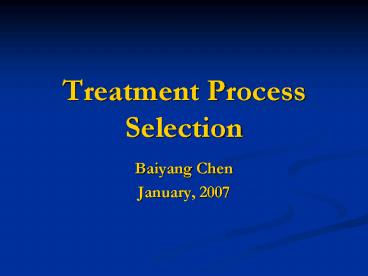Treatment Process Selection - PowerPoint PPT Presentation
1 / 17
Title:
Treatment Process Selection
Description:
Activated Alumina. Ion Exchange. Reverse Osmosis. Electro-Dialysis Reversal ... Activated Alumina (AA) Advantages. Best available technology (BAT) by USEPA ... – PowerPoint PPT presentation
Number of Views:283
Avg rating:3.0/5.0
Title: Treatment Process Selection
1
Treatment Process Selection
- Baiyang Chen
- January, 2007
2
Background
- Occurrence
- Arsenic (As) 0.036 mg/L
- Fluoride (F) 3.2 mg/L
- Total dissolved solids (430 mg/L)
- Maximum contaminant levels (MCLs)
of City of Surprise, AZ and USEPA - As 0.007 mg/L
- F 2.0 mg/L
- TDS 500 mg/L
3
Arsenic (As) Removal
- Best Available Technologies (USEPA)
- Activated Alumina
- Ion Exchange
- Reverse Osmosis
- Electro-Dialysis Reversal
- Oxidation/Filtration
- Enhanced Lime Softening
- Enhanced Coagulation/Filtration
- (---gt 7 is favored! System to be provided by
Layne-Christensen)
4
Fluoride (F) Removal
- Comparison of Processes
- Activated Alumina
- Ion Exchange
- Reverse Osmosis
- Electro-Dialysis Reversal
- Coagulation
- Others researched processes
5
Activated Alumina (AA)
- Advantages
- Best available technology (BAT) by USEPA
- High efficiency (up to 90 removal)
- Removal of arsenic at the same time
- Treatment is cost-effective
- Low water loss (typically 35)
- Low energy consumption
- Limitations
- Works well in narrow pH range (56).
- High TDS and organics can result in fouling
- Presence of other anions can compete
- Regeneration is required and effectiveness of
adsorbent reduces after regeneration - Users do not like the taste of treated water
6
Ion Exchange (IX)
- Advantages
- Also efficient to Arsenic removal
- Easy to operate
- Limitations
- Not a BAT of USEPA
- Efficiency depends on other anions like sulfate,
carbonate, bicarbonate, and phosphate. - Regeneration of resin forms F-concentrated
wastewater - Need adjustment of pH before and after treatment
- Treated water contains high level of chloride
- Cause odorous and DBP problems
7
Reverse Osmosis (RO)
- Advantages
- BAT of USEPA
- Very effective for fluoride (gt90)
- Treat possible contaminants of future concern
- Life of membrane is longer, less regeneration is
needed - High integrity to ensure constant water quality
- No interference by other ions
- Automated, simple operation with little manpower
- Limitations
- More expensive than adsorption methods
- Treated water becomes acidic and needs pH
adjustment - Significant water loss (20)
- Brine is hard to deal with at inland plant
- Impacted by silica content (optimal at lt30mg/L,
silica concentration of 75mg/L may enlarge RO
water loss to 40)
8
Electro-Dialysis Reversal (EDR)
- Advantages
- High removal of all ions
- Not interfered by silica
- Less fouling than RO
- Fully automated
- Chemical addition not required
- Limitations
- Not a BAT of USEPA
- Water loss is high (20)
- More expensive than RO, not economical for TDS lt
3,000 mg/L - Discharge of concentrated brine is a problem
- Side-products like hydrogen gas is dangerous
9
Coagulation-Precipitation
- Limitations
- Low removal efficiency (lt33)
- Optimal condition is not well recognized yet
- High alum dosage needed, 80mg/L Al2(SO4)3 per
1mg/L fluoride - Less Al(OH)3 is formed, leaving more aluminum
occurrence in water - Removal of organic matter is lowered too
- Silica, temperature, and pH can impact the
fluoride removal
10
Other Processes
- Powdered Activated Carbon (PAC)
- Lime Softening (LS)
- Ultrafiltration (UF)
- Nanofiltration (NF)
- Coagulation-Microfiltration (C/MF)
- Electro-coagulation (EC)
- Membrane Distillation (MD)
- Costly. Inefficient. Lack Maturity. etc
11
Recommendation RO System
- Key Reasons
- High efficiency in removing most ions
- Suitable for middle level budget
- Gain credits by treating pollutants of future
concern - Side effects/products can be properly handled
- Concerns can be overcome and not vital for this
project - Manufacturers
- Zenon, Ionics, Severn Trent, GE-Osmonics,
Layne-Christensen, etc
12
Plant Planning
- Procedures
- Treat water by coagulation-filtration process, to
meet arsenic MCL requirement - A portion (40) of water undergo a primary RO
system (with 99 F rejection 20 water loss),
rejected water pass through lime softening,
followed by secondary RO system - Blending RO-treated and non-RO treated water to
meet fluoride MCL standards - Disposal of RO brine in sewage
13
Schematic of RO System for F Removal
14
Expected Results
- Arsenic lt 0.007 mg/L
- Fluoride lt 2.0 mg/L
- Overall water loss 2
- TDS in drinking water lt 263 mg/L
- Brine with TDS of 15,000 mg/L
15
Disposal of RO Brine
- Method
- Discharge to sewage
- TDS 437 mg/L in sewage system
- Pose insignificant effects on WWTP operation.
16
Summary of Plant Design
- Coagulation-filtration is favored for arsenic
removal - Reverse Osmosis (RO) is recommended for fluoride
removal - 40 of water need RO treatment, followed by
blending with non-RO treated water - Minimized water loss (2), As F below MCLs
- RO rejected water can be properly disposed
- Details to be provided upon approval
17
Comments?

